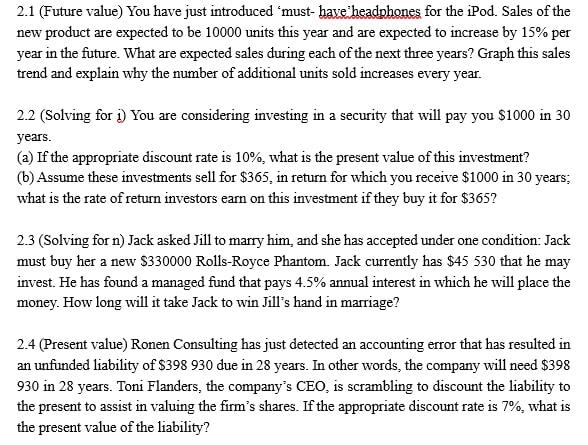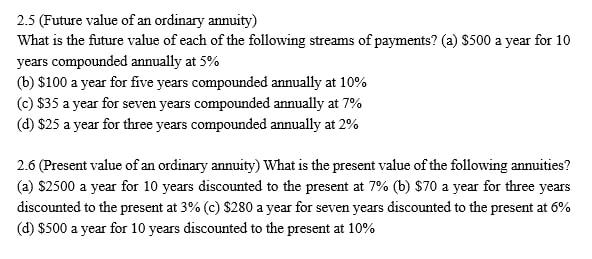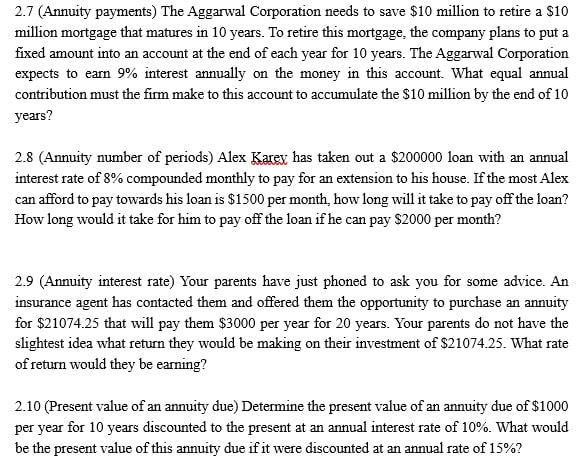



2.1 (Future value) You have just introduced 'must- have'headphones for the iPod. Sales of the new product are expected to be 10000 units this year and are expected to increase by 15% per year in the future. What are expected sales during each of the next three years? Graph this sales trend and explain why the number of additional units sold increases every year. 2.2 (Solving for i) You are considering investing in a security that will pay you $1000 in 30 years. (a) If the appropriate discount rate is 10%, what is the present value of this investment? (b) Assume these investments sell for $365, in return for which you receive $1000 in 30 years; what is the rate of return investors earn on this investment if they buy it for $365? 2.3 (Solving for n ) Jack asked Jill to marry him, and she has accepted under one condition: Jack must buy her a new $330000 Rolls-Royce Phantom. Jack currently has $45530 that he may invest. He has found a managed fund that pays 4.5% annual interest in which he will place the money. How long will it take Jack to win Jill's hand in marriage? 2.4 (Present value) Ronen Consulting has just detected an accounting error that has resulted in an unfunded liability of $398930 due in 28 years. In other words, the company will need $398 930 in 28 years. Toni Flanders, the company's CEO, is scrambling to discount the liability to the present to assist in valuing the firm's shares. If the appropriate discount rate is 7%, what is the present value of the liability? 2.5 (Future value of an ordinary annuity) What is the future value of each of the following streams of payments? (a) $500 a year for 10 years compounded annually at 5% (b) $100 a year for five years compounded annually at 10% (c) $35 a year for seven years compounded annually at 7% (d) $25 a year for three years compounded annually at 2% 2.6 (Present value of an ordinary annuity) What is the present value of the following annuities? (a) $2500 a year for 10 years discounted to the present at 7% (b) $70 a year for three years discounted to the present at 3\% (c) \$280 a year for seven years discounted to the present at 6% (d) $500 a year for 10 years discounted to the present at 10% 2.7 (Annuity payments) The Aggarwal Corporation needs to save $10 million to retire a $10 million mortgage that matures in 10 years. To retire this mortgage, the company plans to put a fixed amount into an account at the end of each year for 10 years. The Aggarwal Corporation expects to earn 9% interest annually on the money in this account. What equal annual contribution must the firm make to this account to accumulate the $10 million by the end of 10 years? 2.8 (Annuity number of periods) Alex Karex has taken out a $200000 loan with an annual interest rate of 8% compounded monthly to pay for an extension to his house. If the most Alex can afford to pay towards his loan is $1500 per month, how long will it take to pay off the loan? How long would it take for him to pay off the loan if he can pay $2000 per month? 2.9 (Annuity interest rate) Your parents have just phoned to ask you for some advice. An insurance agent has contacted them and offered them the opportunity to purchase an annuity for $21074.25 that will pay them $3000 per year for 20 years. Your parents do not have the slightest idea what return they would be making on their investment of $21074.25. What rate of return would they be earning? 2.10 (Present value of an annuity due) Determine the present value of an annuity due of $1000 per year for 10 years discounted to the present at an annual interest rate of 10%. What would be the present value of this annuity due if it were discounted at an annual rate of 15% ? 2.11 (Comprehensive problem) Suppose you are in the second semester of your final year at university and are faced with the choice of either getting a job when you graduate or studying for a Masters degree. Of course, your choice is not purely financial. However, to make an informed decision, you would like to know the financial implications of the two alternatives. Let us assume your opportunities are as follows: - If you take the 'get a job'route you expect to start off with a salary of $50000 per year. There is no way to predict what will happen in the future, but your best guess is that your salary will grow at 5% per year until you retire in 40 years. - If you study for a Masters degree, you will be paying $25000 per year in tuition fees for each of the three years you are studying. However, you can then expect a job with a starting salary of $90000 per year. Moreover, you expect your salary to grow by 7% per year until you retire 37 years later. Clearly, your total expected lifetime salary will be higher if you get a Masters degree. However, the additional future salary is not free. You will be paying $25000 in tuition at the beginning of each of the three years of your Masters program. In addition, you will be giving up more than $157000 in lost income over the three years of additional study: $50000 in the first year, $52500 in the second year, and $55125 in the third year. (a) To start your analysis of whether to study for a Masters degree, calculate the present value of the future earnings that you will realise by going directly to work, assuming a 3% annual discount rate. (b) What is the present value today of your future earnings if you decide to study for a Masters degree, assuming a 3% annual discount rate? Remember that you will be studying for three additional years before you start work. (Hint: Assume you are paid at the end of each year, so that your first salary payment-if you decide to get a Masters degree-occurs four years from now.) (c) If you pay your Masters program tuition fee at the beginning of each year, what is the present value of your tuition fees, assuming a 3% annual discount rate? 2.1 (Future value) You have just introduced 'must- have'headphones for the iPod. Sales of the new product are expected to be 10000 units this year and are expected to increase by 15% per year in the future. What are expected sales during each of the next three years? Graph this sales trend and explain why the number of additional units sold increases every year. 2.2 (Solving for i) You are considering investing in a security that will pay you $1000 in 30 years. (a) If the appropriate discount rate is 10%, what is the present value of this investment? (b) Assume these investments sell for $365, in return for which you receive $1000 in 30 years; what is the rate of return investors earn on this investment if they buy it for $365? 2.3 (Solving for n ) Jack asked Jill to marry him, and she has accepted under one condition: Jack must buy her a new $330000 Rolls-Royce Phantom. Jack currently has $45530 that he may invest. He has found a managed fund that pays 4.5% annual interest in which he will place the money. How long will it take Jack to win Jill's hand in marriage? 2.4 (Present value) Ronen Consulting has just detected an accounting error that has resulted in an unfunded liability of $398930 due in 28 years. In other words, the company will need $398 930 in 28 years. Toni Flanders, the company's CEO, is scrambling to discount the liability to the present to assist in valuing the firm's shares. If the appropriate discount rate is 7%, what is the present value of the liability? 2.5 (Future value of an ordinary annuity) What is the future value of each of the following streams of payments? (a) $500 a year for 10 years compounded annually at 5% (b) $100 a year for five years compounded annually at 10% (c) $35 a year for seven years compounded annually at 7% (d) $25 a year for three years compounded annually at 2% 2.6 (Present value of an ordinary annuity) What is the present value of the following annuities? (a) $2500 a year for 10 years discounted to the present at 7% (b) $70 a year for three years discounted to the present at 3\% (c) \$280 a year for seven years discounted to the present at 6% (d) $500 a year for 10 years discounted to the present at 10% 2.7 (Annuity payments) The Aggarwal Corporation needs to save $10 million to retire a $10 million mortgage that matures in 10 years. To retire this mortgage, the company plans to put a fixed amount into an account at the end of each year for 10 years. The Aggarwal Corporation expects to earn 9% interest annually on the money in this account. What equal annual contribution must the firm make to this account to accumulate the $10 million by the end of 10 years? 2.8 (Annuity number of periods) Alex Karex has taken out a $200000 loan with an annual interest rate of 8% compounded monthly to pay for an extension to his house. If the most Alex can afford to pay towards his loan is $1500 per month, how long will it take to pay off the loan? How long would it take for him to pay off the loan if he can pay $2000 per month? 2.9 (Annuity interest rate) Your parents have just phoned to ask you for some advice. An insurance agent has contacted them and offered them the opportunity to purchase an annuity for $21074.25 that will pay them $3000 per year for 20 years. Your parents do not have the slightest idea what return they would be making on their investment of $21074.25. What rate of return would they be earning? 2.10 (Present value of an annuity due) Determine the present value of an annuity due of $1000 per year for 10 years discounted to the present at an annual interest rate of 10%. What would be the present value of this annuity due if it were discounted at an annual rate of 15% ? 2.11 (Comprehensive problem) Suppose you are in the second semester of your final year at university and are faced with the choice of either getting a job when you graduate or studying for a Masters degree. Of course, your choice is not purely financial. However, to make an informed decision, you would like to know the financial implications of the two alternatives. Let us assume your opportunities are as follows: - If you take the 'get a job'route you expect to start off with a salary of $50000 per year. There is no way to predict what will happen in the future, but your best guess is that your salary will grow at 5% per year until you retire in 40 years. - If you study for a Masters degree, you will be paying $25000 per year in tuition fees for each of the three years you are studying. However, you can then expect a job with a starting salary of $90000 per year. Moreover, you expect your salary to grow by 7% per year until you retire 37 years later. Clearly, your total expected lifetime salary will be higher if you get a Masters degree. However, the additional future salary is not free. You will be paying $25000 in tuition at the beginning of each of the three years of your Masters program. In addition, you will be giving up more than $157000 in lost income over the three years of additional study: $50000 in the first year, $52500 in the second year, and $55125 in the third year. (a) To start your analysis of whether to study for a Masters degree, calculate the present value of the future earnings that you will realise by going directly to work, assuming a 3% annual discount rate. (b) What is the present value today of your future earnings if you decide to study for a Masters degree, assuming a 3% annual discount rate? Remember that you will be studying for three additional years before you start work. (Hint: Assume you are paid at the end of each year, so that your first salary payment-if you decide to get a Masters degree-occurs four years from now.) (c) If you pay your Masters program tuition fee at the beginning of each year, what is the present value of your tuition fees, assuming a 3% annual discount rate










